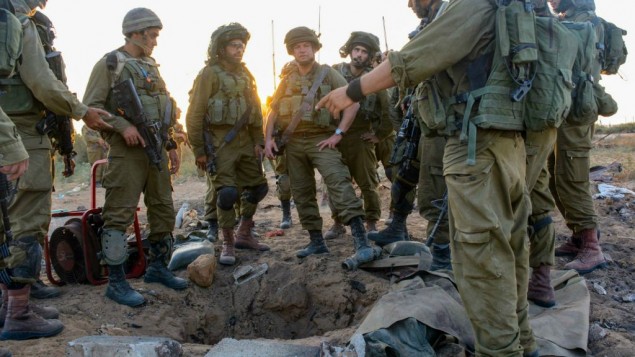The UN report on last summer’s Gaza war, while more even-handed than its predecessor – written shortly after the 2008-2009 conflict – is still willfully or perhaps unknowingly ignorant of modern military affairs. What it needed, aside from Israeli cooperation and an open mind, was a general, preferably one who has commanded troops under fire in either Iraq or Afghanistan.
IDF infantrymen congregating around a tunnel in Gaza on July 24, 2014. The tunnels were used as attack channels into Israel and as means of fighting IDF troops within Gaza. (Courtesy IDF Flickr)
The first thing this officer could have provided is perspective. Whether one accepts the UN death toll, as provided by the Hamas Interior Ministry, or the Israeli one, an international reader still has no way of knowing if the tragic toll in human life – of civilians as opposed to enemy combatants – is disproportionately or even outrageously high.
A senior Israeli officer told me during the war, after detailing all that is being done to spare civilians, that even if the ratio comes out as one militant killed for every two civilians, “I’d sign off on that.”
He said the US ratio in Iraq was far worse than that. Since there are no UN reports investigating US or British actions in Iraq or Afghanistan, and no independent organization chronicling the precise ratios, it is hard to know.
A general would have helped, too, with an understanding of artillery and mortar use. The report actually cited a Times of Israel article about the need to restrict the use of “statistical” weapons in an urban surrounding. This is true. It is needed. But the report fails to discern between offensive targeting and defensive fire.
In Shejaiya, with Hamas handling is military operations “de facto” from al-Wafa hospital, according to an Israeli investigation, the intense artillery blasts, consisting of 600 rounds within the span of an hour, was defensive. It was needed because Israeli troops were trapped under fire. A more serious report would discern the difference between these two situations.
Another problem is the lack of study of Hamas doctrine. The claim that Israel may have committed war crimes by failing to differentiate between civilians and combatants could use a careful illustration of the way Hamas builds its own fortifications – hiding weapons in mosques, and situating rockets near schools and medical clinics.
That said, the report is right to put the onus on Israel’s Military Advocate General’s Corps to investigate the Israel Defense Forces. Of course, distinguishing between enemies and civilians is difficult during a modern war and it is complicated by an enemy that often poses as a civilian – either wearing women’s clothes or traveling in an ambulance.
But if the IDF is to credibly counter the stated “lamentable track record in holding wrongdoers accountable,” it must, for instance, either charge the soldiers involved in the July 23 and July 25 incidents in Khuza’a – in which civilians waving white flags were targeted and, in one case, killed – or explain the details of the incident.
The final operational issue is proportionality. There is no formula to judge whether an attacking army is acting within the confines of that law. And yet it is possible that the army, as the report asserts, may have exceeded its limits during the hours immediately after the August 1 abduction of Lt. Hadar Goldin. Operating amid the shock of a Hamas-ruptured ceasefire and the news of a soldier’s abduction – an Israeli Achilles’ heel – the army reportedly fired 2,000 pieces of ordnance on Rafah during the morning hours.
Dozens of civilians were killed. The report states that, according to some, “the proportionality test may take into account strategic considerations in determining the military advantage.” In other words, that denying Hamas the leverage of holding an Israeli captive is central to Israel’s military objective and therefore a massive counter-strike is warranted. The commission rejected this out of hand, stating that this “is not [a] valid consideration.” The leverage, the report explained, “does not depend solely on the capture of a soldier, but on how the Government of Israel decides to react to the capture in the aftermath.”
This isolated case requires the opinion of the MAG Corps as the IDF looks ahead to future conflicts, in which the enemy will continue to try and attack Israel’s soft spot. A military authority on the panel, though, along with Israeli cooperation and a willingness to accept Israeli facts about the army’s targeting practices – and not merely the anonymous testimony of Breaking the Silence – would likely have shown the truth about this war: It was awful, of course, but while the Palestinians undoubtedly suffered and continue to suffer more than Israelis, the very fact of this suffering does not make the IDF and the government of Israel guilty of systemic war crimes.
The report did spread the blame to Hamas and inserted some doubt into its own rather far-reaching allegations, stating that Israel “may” have committed war crimes, rather than stating it as fact, as Judge Richard Goldstone did in 2009, before reality forced him to recant.
Article Source- http://www.timesofisrael.com/next-time-ask-a-general/










